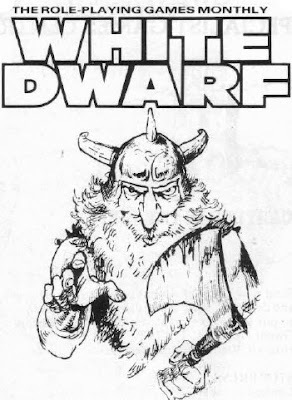White Dwarf: Final Thoughts
 Having come to the end of my look back at the first 80 issues of White Dwarf last week, I thought, before launching a new series, I'd offer some final thoughts on the UK's most successful and influential "games monthly."
Having come to the end of my look back at the first 80 issues of White Dwarf last week, I thought, before launching a new series, I'd offer some final thoughts on the UK's most successful and influential "games monthly."As I noted in my original retrospective on White Dwarf almost fifteen(!) years ago, I was an irregular reader of the magazine during my youth. I'd pick up an issue here or there, as I could find them and subscribed to it between 1983 and '85, but I was never as devoted to White Dwarf as I was to Dragon during my formative years in the hobby. Consequently, until I'd made the effort to work my way through its first 80 issues for this series, I can't honestly say that I had a truly good sense of White Dwarf' and its place in the history of the hobby. With the benefit of my recent education, I know a little better, though still in a slightly more "academic" way than those of you, both in Britain and elsewhere, who experienced the magazine in its original run.
I'm left with three insights I'd like to share. The first is a direct result of my having grown up on the other side of the Atlantic, namely, that White Dwarf was a window on another part of the hobby that I otherwise would never have seen. Hard as it is to remember now, given the speed and ease of contemporary telecommunications, the world of the late '70s and early '80s was much more divided and diverse. Certainly, there were global fads and trends, but they took longer to spread and, even when they did, they often manifested in unique ways in each country where they took hold. This is something I genuinely miss about the past, especially when compared to bland corporate slurry that predominates in so many fields today.
White Dwarf revealed to me, growing up in suburban Baltimore, Maryland, what roleplaying was like in Great Britain. I was frequently surprised not merely by the differences in content – the preponderance of RuneQuest articles during the time I was a subscriber, for example – but also by the differences in subject matter and presentation. White Dwarf's artwork was utterly unlike anything I'd seen in Dragon – dark, bizarre, and waggish, by turns gothic and punk. I didn't always like it, but it always held my attention, no doubt because it was genuinely different than the increasingly safe, antiseptic house style of TSR. Likewise, the content of most issues displayed a similar difference from what I was used to – a greater use of history, horror, and, of course, humor. Reading White Dwarf, there was never any question I was reading the product of another culture and that was (and is) quite appealing.
My second insight is that White Dwarf seems to have retained the madcap, chaotic energy of the early hobby longer than did Dragon or indeed most of the hobby on this side of the Atlantic Ocean. To some extent, this slightly scruffy, rough around the edges style became Games Workshop's brand identity, so it's possible that this seeming atavism might simply have been very good marketing. Still, there's no denying that it's slightly intoxicating, even at several decades' remove. One of the things I really enjoyed about reading and re-reading the issues I covered in this series is once again feeling the vigor and enthusiasm of youth. I could sometimes feel the excitement of an article's author, the desire to share this absolutely crazy idea he hit upon one day while playing D&D with his mates one Saturday night. It's amazing stuff and, while this didn't always translate into a good or even usable article, I can't help but appreciate the fervor that engendered it.
Thirdly, and relatedly, I'd say that, when White Dwarf started to decline, its decline seemed far starker than that of Dragon. In part, I think that's because WD stayed closer to the wild, untidy roots of the hobby for longer into its run, making its eventual transition to a slick, safe house organ that much more apparent. Despite this, the magazine continued to offer up excellent articles until the very end of the time that I was reading it. Indeed, I have little doubt that, had I continued to do so, I'd have continued to find good material in its pages, maybe even great material. Yet, I also know that, by the tail end of the 1980s, White Dwarf was no longer the shambolic, quasi-amateur periodical that it had been at the start of the decade and that's a shame. What I most liked about White Dwarf, then and now, was its vitality. After a certain point – precisely when is probably hard to pin down – it was no longer a feral animal but a caged one.
Like Dragon, White Dwarf is one of the places where the hobby as we know was nurtured. It was the crucible of so much that has subsequently come to be known as "British fantasy," as well as the launching pad for the careers of many writers who would later gone to have a profound influence not just on the hobby but on fantasy and science fiction as well. Though it's still running to this day – the same cannot be said of Dragon or indeed any gaming magazine of my youth – it's a hollow imitation of what it was once was, not to mention a reminder of just how good it was in its early days. We shall not see its like again.
James Maliszewski's Blog
- James Maliszewski's profile
- 3 followers



